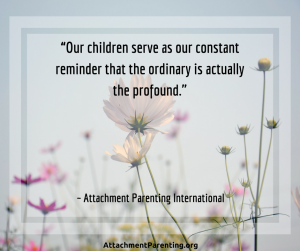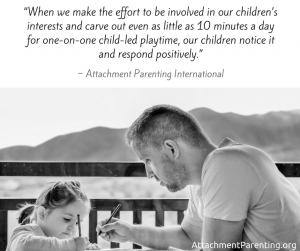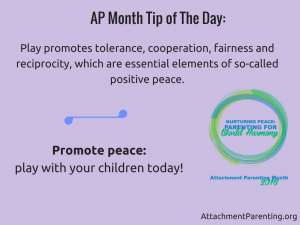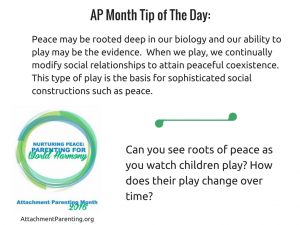Category: Play
4 tips for cultivating a “yes environment”
 Children hear the word “no” about 400 times a day. Being told “no” constantly doesn’t feel good and often times can be frustrating. The more children hear it, the more likely they are to have tantrums and power struggles, and feel disconnected from their parents.
Children hear the word “no” about 400 times a day. Being told “no” constantly doesn’t feel good and often times can be frustrating. The more children hear it, the more likely they are to have tantrums and power struggles, and feel disconnected from their parents.
Creating a “yes environment” can help families to feel happier and more connected.
This doesn’t mean you must say “yes” to literally everything, or that the word “no” should be nonexistent. It’s important to keep boundaries and to set the limits that are right for your family. The point of creating a “yes environment” is to save the “no” for the occasional vital situations — safety reasons, things that go against family rules, or times when something truly isn’t possible to do.
Here are 4 tips for cultivating a “yes environment”:
- Make sure your “no” is really a no — Sometimes we say “no” to a request before we even really think about it. It’s important to take the time to think before answering children’s requests. For example, Is it really unsafe when my sons are roughhousing? Can I make it safer by removing obstacles from the room and helping them set some ground rules? Or, Do I have the time to do this art project? Am I inclined to say “no” just because I don’t want to deal with the potential mess? There are many times when my children will ask to go the playground, but I simply don’t feel like it and I want to start thinking of every excuse not to go. However, when I try to stay in “yes” mode and give it a try, so often I have more fun than expected. I end up feeling grateful that I chose to have that moment of connection with my children and to say “yes” to adventures and exploration.
- Save “no” for when it matters — When we say “no” all the time, the word loses some of its significance and effectiveness. “No” is a strong word. Our children need to know that it really matters. That’s important both in having them listen to and respect people who tell them “no,” as well as in situations where their own “no” needs to be respected by other people. When we save “no” for the situations that really matter, it makes the word more powerful — our children know that we indeed mean it.
 “Yes…later” — Sometimes your child will ask to do something that would be a “yes” at a different time, like wanting to go to the playground shortly before you need to pick up an older child from school. Instead of saying, “No, we can’t go now. We don’t have time,” you might say, “Yes, we can go to the park after we get your sister from school.” Reframing your words in a positive way, rather than using negative language, is helpful to children.
“Yes…later” — Sometimes your child will ask to do something that would be a “yes” at a different time, like wanting to go to the playground shortly before you need to pick up an older child from school. Instead of saying, “No, we can’t go now. We don’t have time,” you might say, “Yes, we can go to the park after we get your sister from school.” Reframing your words in a positive way, rather than using negative language, is helpful to children.- Explain the “no” — Imagine your toddler is pulling your hair. Your first inclination may be to say, “No!” After all, it hurts, you’re angry, and you want to make it clear that it’s not OK. A more positive way to handle it would be to remain calm and say instead, “That hurts Mommy,” as you move her hand away from your hair. You’re not using the word “no,” but you’re also not allowing the behavior. Explaining it to her in this way will help her understand why you’re stopping their behavior. It also helps develop empathy and gives young children exposure to more language than just “no.”
Even just 10 minutes a day with our child
Building a strong parent-child bond through Playful Parenting
 One of the most important and challenging undertakings of parenting is to build strong, close bonds between children and their parents. A strong parent-child connection enables children to become confident, independent, develop healthy relationships, and become a peaceful adult.
One of the most important and challenging undertakings of parenting is to build strong, close bonds between children and their parents. A strong parent-child connection enables children to become confident, independent, develop healthy relationships, and become a peaceful adult.
In his book Playful Parenting, Dr. Lawrence Cohen points out that through play, children explore the world, work through challenging situations and get connected with the people they are close with.
I have found that approaching common parenting struggles with Playful Parenting techniques to be very effective, and it helps to make things easier and more fun for everyone in our family.
Through play, we get to join our children’s world — promoting mutual respect, exploration, and cooperation while enjoying each other’s company.
Using Play to Manage Parenting Struggles
Parents of young children experience many situations where the child resists when they’re asked to do something: They don’t want to pick up their toys or get dressed to go out; they don’t want their hair washed or their nails cut. The list goes on. Making a game out of these tasks can help. It instantly makes the activity more fun and enjoyable for the child and makes it something they’re much less likely to resist.
When my toddler son was into recycling and trash trucks, we made a game of cleaning up his blocks by saying, “Let’s put all the trash in the trash truck.” The blocks were the trash, and the container was the trash truck. When he was 3 and very much into firefighters, we made a game of getting dressed to leave the house by saying, “There’s a fire! It’s time to get in the fire truck. Let’s get on our fire coats and boots!” He’d then be quick to get on his shoes and coat to get in the car.
Many times, parents think they don’t have time for such games. You’re in a hurry to get out the door, so why add in a game and waste more time? But I find that when we play our way through it like this, it actually takes less time for my children to get ready.
Some critics say that parents shouldn’t have to do this and that a child shouldn’t need a game to make them listen. While it’s true that they don’t need it, and there are many other ways to help children cooperate, it does make it more enjoyable. Just like, as an adult, I find it’s more enjoyable to clean while listening to music, or to fold laundry while watching TV. It’s the same concept.
Playing Your Way Through Fears
Play can help release tension and can make what seems scary into something silly. In this way, it can be used to help children work through their fears.
When my son was 4, he was scared during thunderstorms. The sudden sound of thunder was too startling for him, and it kept him tense at bedtime. One night during a storm, I said to him, “What do you think that thunder sounds like? I think it sounds like a train rumbling down the track.” He loved Thomas the Train, so I suggested, “Maybe it’s Thomas!” He started to laugh, and I kept going: “That was really loud. It must’ve been Gordon, because he’s so big!” This turned it into a fun game and made the experience less scary.
Play can also help with minor stresses. A child may come home upset after a hard day at school but then may get to work out some of those emotions by playing school where he is the teacher and in charge.
Dr. Cohen talks more about the idea of using play to handle childhood anxiety in his book The Opposite of Worry.
Connecting with Children Through Play
One part of Playful Parenting is about strengthening connection between parent and child. Children who feel connected and attached to their parents feel closer to them and thus want to cooperate with them. One simple and effective way to connect with our children is to sit and play with them.
Playing can be hard for adults: We’re out of practice, or have low patience, we may have forgotten how to play, or simply feel like we don’t have the time for it. Some people may feel awkward or embarrassed about being silly and goofy if they participate in children’s imaginative play, like a dad who may not want to sit and play with dolls with his young daughter.
However, when we make the effort to be involved in our children’s interests and carve out even as little as 10 minutes a day for one-on-one child-led playtime, our children notice it and respond positively. Deepening our connection with our children makes them more likely to respect us and to want to do what we ask of them. It helps them feel secure and loved, and makes us all happier.
13 Attachment Parenting hacks
 Attachment Parenting is more than a tick-boxed scorecard of babywearing and breastfeeding. It is so very much more.
Attachment Parenting is more than a tick-boxed scorecard of babywearing and breastfeeding. It is so very much more.
Attachment Parenting, for many of us, is a way of life. In its simplest of forms, it’s about choosing connection and respect over convenience and quick-wins.
The following advice has been lifted — with permission! — from one of my favorite virtual parent support groups. The points summarize 13 Attachment Parenting hacks from real — albeit virtual — moms that might just revolutionize the way you think about parenting:
- “Pause before reacting to anything. The very few genuine emergencies that require instant reactions will get them before you can even think.” (Linda)
- “When a kid is upset, don’t try to make them feel better. Just try to make it clear that you get why they are upset.” (Nina)
- “Sing and play! Everything is still fairly new and exciting to a child. Let them join in what you’re doing, and join in what they’re doing.” (Jenna)
- “A baby is its own instruction manual.” (Lisa)
- “Not all kids can cope with choices.” (Linda)
- “Laughing together with a child is a powerful way of connecting and a healing tool for both of you.” (Rosetta)
- “When in doubt, err on the side of love.” (Marina)
- “Asking a question and giving a child the power to answer and be heard, is an amazing thing.” (Lily)
- “Put a crabby baby into water…let the splashing commence!” (Michelle)
- “Make your home a ‘yes’ environment.” (Claire)
- “Piggy back rides!” (Katie)
- “If you can give your children a chance to have control over something, do it.” (Tia)
- “Never regard your relationship with your kids as a rivalry (them vs. me). It’s ALWAYS a partnership.” (Bonnie)
Connecting through creativity and art
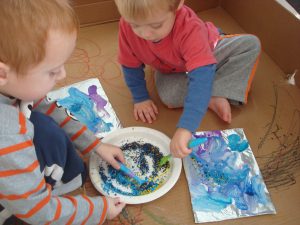 Doing art projects and other creative activities with my kids is something that’s very important to me. As a child, I always disliked Art Class because I knew I wasn’t very good at art, but starting when my oldest son was 2, I wanted to make art a part of his life. I wanted to let it be something he could enjoy, whether or not he was good at it.
Doing art projects and other creative activities with my kids is something that’s very important to me. As a child, I always disliked Art Class because I knew I wasn’t very good at art, but starting when my oldest son was 2, I wanted to make art a part of his life. I wanted to let it be something he could enjoy, whether or not he was good at it.
Over the last few years, art has been a way for us to connect, have fun, and learn.
Allowing children opportunities to create their own art is a wonderful way to help instill creativity and confidence. It can also provide sensory experiences, fine motor activities, and chances to learn about different styles of art.
To first get started with art activities, I spent some time walking around a craft store and selecting items that either seemed like the basics (paint, markers, and glue) or like they’d be really fun (googly eyes and pompoms). While I was there, I also picked up some 5d diamond painting kits for myself to break my hiatus and resume my painting hobby. I also got project ideas from the many blogs dedicated to toddler and preschool art.
Our activities have been very different based on my children’s ages. When my son was 2 and we were just starting, we did a lot of finger painting, sensory activities with things like rice and oatmeal, and water play with cups, bowls, and spoons. As a preschooler, he experimented with painting with strange objects like ribbons and flowers, and we explored some famous artists. I loved painting of few artists and also decided to hung it at my home for him, so after seeing painting he can get more interest into painting. I decided to get a Pet paint by visiting the custom painting online. Now that he’s 6, we’ve been getting art books from the library for him to select project ideas from, and he’ll help pick out art supplies that he wants to use.
We both try our best to remember that it’s about having fun, not about having a perfect finished product.
When my second and third children were born, I found ways to get them involved in art at an earlier age. I found baby-friendly activities, such as filling a container with colorful tissue paper or a variety of fabric scraps with different textures, and placing paint and a paper inside a sealed plastic bag for them to smoosh around and make their first paintings — completely mess-free.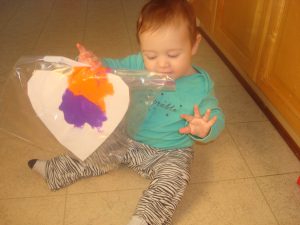
For us, art has been one way to connect. After my second child was born, it was also a way to have some much-needed one-on-one time with my oldest son while his baby brother was napping. For other families, there may be different but equally fulfilling ways of achieving this, if art isn’t interesting to you or it’s not something you can make time for right now. It’s important to explore and find your own ways of connection.

